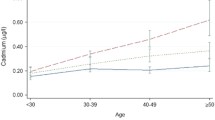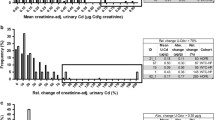Abstract
The COPHES/DEMOCOPHES twin project was performed in 2011–2012 in 17 European countries to harmonize all steps of the human biomonitoring survey. Urinary cadmium, cotinine, phthalate metabolites, and hair mercury were measured in children (N = 120, 6–11 years) and their mothers of reproductive age, living in urban or rural areas. Cadmium in mothers’ and children’s urine was detected at a geometric mean (GM) concentration 0.227 and 0.109 μg/L, respectively; 95th percentile (P95) was 0.655 and 0.280 μg/L in mothers and children, respectively. No age-related, education-related, or urban versus rural differences were observed within the frame of each population group. Cadmium urinary level in mothers was about twofold compared with children. Higher levels were obtained in all smoking mothers but not in occasionally smoking or mothers and children exposed to environmental tobacco smoke (ETS). Mercury values in mothers were significantly higher in urban than in rural populations but not in children. GM and P95 for mercury in children’s hair were 0.098 and 0.439 μg/g and in mothers’ hair were 0.155 and 0.570 μg/g. Concentrations for mercury in the Czech samples were lower than European average. Hair mercury increased significantly with consumption of fish or seafood and with number of amalgam tooth fillings (in children). A positive association was found with family educational level. No influence of age was observed. Urinary cadmium and hair mercury levels were lower than health-based guidelines with one exception. High levels of urinary cotinine were found in the 12 smoking mothers (GM approximately 500 μg/L); lower levels in occasionally smoking mothers, N = 11 (34.5 μg/L). The mean cotinine levels in nonsmoking mothers who reported daily exposure to ETS was 10.7 μg/L. A similar mean value (10.8 μg/L) was obtained in six children who had daily exposure to ETS. In children without exposure to ETS, the mean cotinine level was 1.39 μg/L urine. Cotinine in the urine of children demonstrates limited protection of the Czech children against exposure to ETS.

Similar content being viewed by others

References
Åkesson A, Lundh T, Vahter M, Bjellerup P, Lidfeldt J, Nerbrand C et al (2005) Tubular and glomerular kidney effects in Swedish women with low environmental cadmium exposure. Environ Health Perspect 113:1627–1631. doi:10.1289/ehp.8033
Angerer J, Schaller K (eds) (2001) Analyses of hazardous substances. Biol Mater 8:55–64
Angerer J, Aylward LL, Hays SM, Heinzow B, Wilhelm M (2011) Human biomonitoring assessment values: approaches and data requirements. Int J Hyg Environ Health 214:348–360. doi:10.1016/j.ijheh.2011.06.002
Apel P, Angerer J, Wilhelm M, Kolossa-Gehring M (2016) New HBM values for emerging substances, inventory of reference and HBM values in force, and working principles of the German Human Biomonitoring Commission. Int J Hyg Environ Health. doi:10.1016/j.ijheh.2016.09.007
Bardoděj Z, Urban J, Maloňová H (1987) Important considerations in the development of biological monitoring methods to determine occupational exposure to organic chemicals. In: Ho M, Dillon H (eds) Biological monitoring of exposure to chemicals. Wiley, New York, pp 17–28
Batáriová A, Spěváčková V, Beneš B, Čejchanová M, Šmíd J, Černá M (2006) Blood and urine levels of Pb, Cd and Hg in the general population of the Czech Republic and proposed reference values. Int J Hyg Environ Health 209:359–366. doi:10.1016/j.ijheh.2006.02.005
Becker K, Kaus S, Krause C, Lepom P, Schulz C, Seiwert M, Seifert B (2002) German Environmental Survey 1998 (GerES III): environmental pollutants in blood of the German population. Int J Hyg Environ Health 205:297–308. doi:10.1078/1438-4639-00155
Becker K, Seiwert M, Casteleyn L, Joas R, Joas A, Biot P et al (2014) A systematic approach for designing a HBM pilot study for Europe. Int J Hyg Environ Health 217:312–322. doi:10.1016/j.ijheh.2013.07.004
Bellanger M, Pichery C, Aerts D, Berglund M, Castaño A, Cejchanová M et al (2013) Economic benefits of methylmercury exposure control in Europe: monetary value of neurotoxicity prevention. Environ Health 12:3. doi:10.1186/1476-069X-12-3
Bencko V (1995) Use of human hair as a biomarker in the assessment of exposure to pollutants in occupational and environmental settings. Toxicology 101:29–39. doi:10.1016/0300-483X(95)03018-B
Beneš B, Spěváčková V, Šmíd J, Čejchanová M, Kaplanová E, Černá M et al (2002) Determination of normal concentration levels of Cd, Pb, Hg, Cu, Zn and Se in urine of the population in the Czech Republic. Cent Eur J Public Health 10:3–5
Berglund M, Larsson K, Grandér M, Casteleyn L, Kolossa-Gehring M, Schwedler G et al (2015) Exposure determinants of cadmium in European mothers and their children. Environ Res 141:69–76. doi:10.1016/j.envres.2014.09.042
Bernard A, Lauwerys R (1986) Present status and trends in biological monitoring of exposure to industrial chemicals. J Occup Med 28:558–562
Castaño A, Cutanda F, Esteban M, Pärt P, Navarro C, Gómez S et al (2015) Fish consumption patterns and hair mercury levels in children and their mothers in 17 EU countries. Environ Res 141:58–68. doi:10.1016/j.envres.2014.10.029
Casteleyn L, Tongelen B, Fátima M, Polcher A, Joas R (2007) Human biomonitoring: towards more integrated approaches in Europe. Int J Hyg Environ Health 210:199–200. doi:10.1016/j.ijheh.2007.01.001
CDC (2001) National report on human exposure to environmental chemicals. Centers for Disease Control and Prevention. National Center for Environmental Health, Division of Laboratory Sciences. Georgia. 59 p. NCEH Pub. No. 01-0379. www.cdc.gov/nceh/dls/report
CDC (2006) The health consequences of involuntary exposure to tobacco smoke: a report of the surgeon general – Executive summary. Department of Health and Human Services, Coordinating Center for Health Promotion, Office on Smoking and Health. 27 p. http://www.cdc.gov/tobacco
Čejchanová M, Spěváčková V, Kratzer K, Wranová K, Spěváček V, Beneš B (2008) Determination of mercury and methylmercury in hair of the Czech children’s population. Biol Trace Elem Res 121:97–105. doi:10.1007/s12011-007-8034-2
Černá M, Spěváčková V, Čejchanová M, Beneš B, Rössner P, Bavorová H et al (1997) Population-based biomonitoring in the Czech Republic—the system and selected results. Sci Total Environ 204:263–270. doi:10.1016/S0048-9697(97)00186-1
Černá M, Sochorova L, Hanzlikova L, Drgacova A, Grafnetterova A, Cejchanova M et al (2016) EHM, Annual report for 2015 (in Czech) [WWW Document]. http://www.szu.cz/tema/zivotni-prostredi/odborne-zpravy-1. Accessed 4 Jan 2017
Černá M, Puklová V, Hanzlíková L, Sochorová L, Kubínová R (2016) 25 years of HBM in the Czech Republic. Int J Hyg Environ Health
Cox B, Vangronsveld J, Nawrot TS (2014) Impact of stepwise introduction of smoke-free legislation on population rates of acute myocardial infarction deaths in Flanders, Belgium. Heart 100:1430–1435. doi:10.1136/heartjnl-2014-305613
Den Hond E, Govarts E, Willems H, Smolders R, Casteleyn L, Kolossa-Gehring M et al (2015) First steps toward harmonized human biomonitoring in Europe: demonstration project to perform human biomonitoring on a European scale. Environ Health Perspect 123:255–263. doi:10.1289/ehp.1408616
Dostál M, Milcová A, Binková B, Kotesovec F, Nozicka J, Topinka J et al (2008) Environmental tobacco smoke exposure in children in two districts of the Czech Republic. Int J Hyg Environ Health 211:318–325. doi:10.1016/j.ijheh.2007.07.001
EU Commission (2004) Communication from the Commission to the Council, the European Parliament, the European Economic and Social Committee—“The European Environment & Health Action Plan 2004–2010” {SEC(2004) 729}/* COM/2004/0416 Vol. I final */[WWW Document]. http://eur-lex.europa.eu/legal-content/EN/TXT/?uri=celex%3A52004DC0416. Accessed 24 Mar 2017
Ewers U, Krause C, Schulz C, Wilhelm M (1999) Reference values and human biological monitoring values for environmental toxins. Report on the work and recommendations of the Commission on Human Biological Monitoring of the German Federal Environmental Agency. Int Arch Occup Environ Health 72:255–260. doi:10.1007/s004200050369
Fiddicke U, Becker K, Schwedler G, Seiwert M, Joas R, Joas A et al (2015) Lessons learnt on recruitment and fieldwork from a pilot European human biomonitoring survey. Environ Res 141:15–23. doi:10.1016/j.envres.2014.08.039
Fiolet DCM, Cuijpers CEJ, Ritsema R, Lebret E (1999) Biological monitoring of metals in the general Dutch population: reference values, trends and determinants. Epidemiology 10(Suppl):72
Hays SM, Nordberg M, Yager JW, Aylward LL (2008) Biomonitoring Equivalents (BE) dossier for cadmium (Cd) (CAS No. 7440-43-9). Regul Toxicol Pharmacol. doi:10.1016/j.yrtph.2008.05.008
Horton LM, Mortensen ME, Iossifova Y, Wald MM, Burgess P (2013) What do we know of childhood exposures to metals (arsenic, cadmium, lead, and mercury) in emerging market countries? Int J Pediatr. doi:10.1155/2013/872596
Jarvis MJ, Tunstall-Pedoe H, Feyerabend C, Vesey C, Saloojee Y (1987) Comparison of tests used to distinguish smokers from nonsmokers. Am J Public Health 77:1435–1438. doi:10.2105/AJPH.77.11.1435
JECFA (2004) Evaluation of certain food additives and contaminants. Sixty-first report of the joint FAO/WHO expert committee on food additives. WHO Technical Report Series 922; WHO Geneva, pp 127–132
Joas R, Casteleyn L, Biot P, Kolossa-Gehring M, Castano A, Angerer J (2012) Harmonised human biomonitoring in Europe: activities towards an EU HBM framework. Int J Hyg Environ Health 215:172–175. doi:10.1016/j.ijheh.2011.08.010
Lopez-Herranz A, Cutanda F, Esteban M, Pollan M, Calvo E, Perez-Gomez B (2016) Cadmium levels in a representative sample of the Spanish adult population: the BIOAMBIENT.ES project. J Expo Sci Environ Epidemiol 26(5):471–480
Orton S, Jones LL, Cooper S, Lewis S, Coleman T (2014) Predictors of children’s secondhand smoke exposure at home: a systematic review and narrative synthesis of the evidence. PLoS ONE. doi:10.1371/journal.pone.0112690
Puklová V, Krsková A, Černá M, Čejchanová M, Řehůřková I, Ruprich J (2010) The mercury burden of the Czech population: an integrated approach. Int J Hyg Environ Health 213:243–251. doi:10.1016/j.ijheh.2010.02.002
Ruprich J, Černoevičová M, Kopřiva V, Resová D, Řehůřková I (1993) Food basket for the Czech Republic, exposure factors—CZ 1991. National Institute of Public Health, Prague (in Czech)
Satarug S, Vesey DA, Gobe GC (2017) Kidney cadmium toxicity, diabetes and high blood pressure: the perfect storm. Tohoku J Exp Med 241:65–87
Schindler BK, Esteban M, Koch HM, Castano A, Koslitz S, Cañas A et al (2014) The European COPHES/DEMOCOPHES project: towards transnational comparability and reliability of human biomonitoring results. Int J Hyg Environ Health 217:653–661. doi:10.1016/j.ijheh.2013.12.002
Schneiderka P, Pacakova V, Stulik K, Kloudova M, Jelinkova K (1993) High-performance liquid-chromatographic determination of creatinine in serum, and a correlation of the results with those of the Jaffe and enzymatic methods. J Chromatogr Appl 614:221–226. doi:10.1016/0378-4347(93)80312-R
Schulz C, Wilhelm M, Heudorf U, Kolossa-Gehring M (2012) Reprint of “Update of the reference and HBM values derived by the German Human Biomonitoring Commission”. Int J Hyg Environ Health 215:150–158. doi:10.1016/j.ijheh.2012.01.003
Smolders R, Den Hond E, Koppen G, Govarts E, Willems H, Casteleyn L et al (2015) Interpreting biomarker data from the COPHES/DEMOCOPHES twin projects: using external exposure data to understand biomarker differences among countries. Environ Res 141:86–95. doi:10.1016/j.envres.2014.08.016
U.S. EPA (2001) Water quality criterion for the protection of human health: methylmercury. US Environmental Protection Agency, Washington, DC EPA-823-R-, 303
Waseem A, Arshad J (2016) A review of human biomonitoring studies of trace elements in Pakistan. Chemosphere 163:153–176. doi:10.1016/j.chemosphere.2016.08.011
WHO (1996) Biological monitoring of chemical exposure in the workplace—guidelines [WWW Document]. http://apps.who.int/iris/handle/10665/41856?mode=full
Wranová K, Čejchanová M, Spěváčková V, Korunová V, Vobecký M, Spěváček V (2009) Mercury and methylmercury in hair of selected groups of Czech population. Cent Eur J Public Health 17:36–40
Acknowledgements
The authors thank the European Commission Directorate-General for Research and Innovation (RTD) that funded the COPHES project in the 7th Framework Program (No. 244237). The DEMOCOPHES project (LIFE09ENV/BE/000410) received funding through the LIFE + financial instrument of the European Commission (DGENV). In the Czech Republic, DEMOCOPHES project was cofunded by the Ministry of Education, Youth, and Sports of the Czech Republic No. 7EX11063 and Prvouk PE 02 Environmental Research, Charles University in Prague. The authors appreciate the contribution of the field workers and laboratory staff, namely Šárka Dušková, Iveta Hanzlíková, and Ludmila Dabrowská. They also acknowledge all donors of biological material.
Author information
Authors and Affiliations
Corresponding author
Rights and permissions
About this article
Cite this article
Forysová, K., Pinkr-Grafnetterová, A., Malý, M. et al. Urinary Cadmium and Cotinine Levels and Hair Mercury Levels in Czech Children and Their Mothers Within the Framework of the COPHES/DEMOCOPHES Projects. Arch Environ Contam Toxicol 73, 421–430 (2017). https://doi.org/10.1007/s00244-017-0412-y
Received:
Accepted:
Published:
Issue Date:
DOI: https://doi.org/10.1007/s00244-017-0412-y



